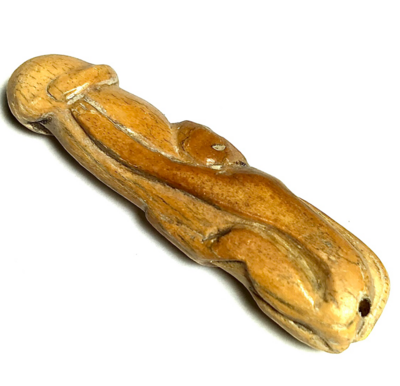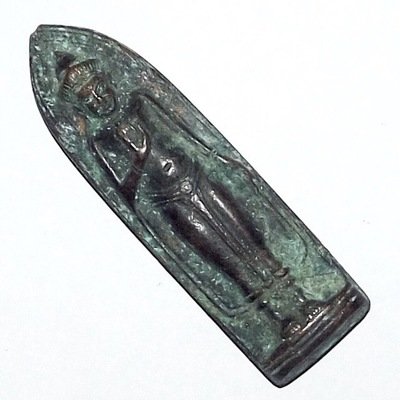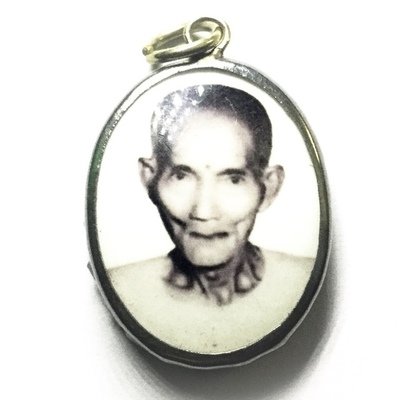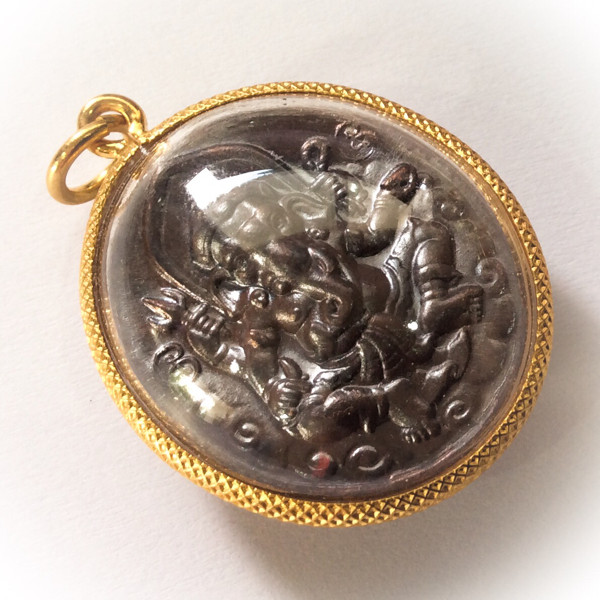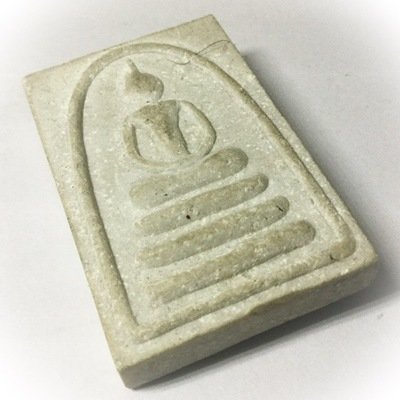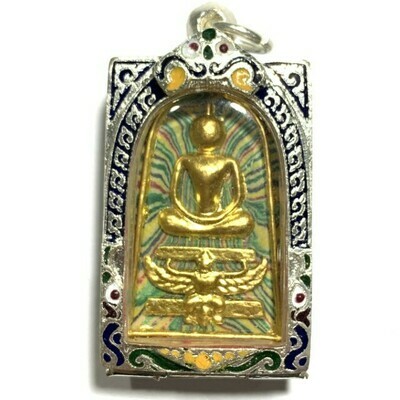
Ancient Amulet Store – Purveyors of preferred Classic Thai Buddhist Amulets for the True Devotee and Distinguished Collector
Discover the immensely deep and fascinating world of Vintage Thai Buddhist Amulets. Ancient Amulet is a long term established and internationally recognized Vintage Amulet Shop, and A Trusted Source for Classic Thai Buddhist Amulets for Devotees and Discerning Collectors, and is one of the many sub projects of informational sources created by Thai Amulet, Buddhism and Thai Occult Expert, Ajarn Spencer Littlewood . as part of his ‘Buddha Magic Project‘
Ancient Amulet provides authentic Antique and Rare Thai Amulets of the Pre and Early Post-Modern Era, of high esteem and Sacred Value, to revere, study and collect. Our Ancient Thai Buddhist Amulets are selected from the finest exhibits we can discover, and given diligent study and authentication processes. Our collection showcases time-honored amulets crafted by ancient masters, boasting captivating qualities and representing the esteemed Pra Niyom class. We offer authentic, highly valued ancient Thai Buddhist amulets from the pre and early post-modern eras, carefully selected from the finest exhibits and thoroughly examined. We invite you to study, revere, and collect these classic amulets from ancient masters, and to learn about their magical aspects and the art of amulet evaluation
Rian Pra Pikanes Nuea Tong Daeng 2539 BE - Gold Plated Casing - Luang Por Lae Wat Pra Song (Petchburi)
This most beautiful Ganesha Coin in Nuea Tong Daeng Rom Man Pu (reddish oily polished copper), is a very rare to see acquisition, that was blessed and empowered by the Great Sak yant Master Luang Por Lae of Wat Pra Song in Petchburi. Released in the year 2539 BE, the amulet is now not only of a respectable age, and from a deceased Great Guru Master whose amulets are not often seen in circulation, but also is in pristine condition and still in the original box from the temple.
The image of Pikanes is incredibly detailed and surely designed by one of the Artists of the University of Fine Buddhist Arts. Its detail and balance of proportion is of the finest craftsmanship, as is the metallurgical aspect of this sacred amulet for prosperity and professional success.

The amulet is encased in Waterproof Gold Plated Casing, ready for wearing. This amulet was released in two versions of casing; solid silver, and gold plated.

The rear face of the amulet bears a 'Siarn Por Gae' Lersi Head Image, invoking the blessings and protection of the Lersi to guard over and and improve the lives of the wearer. The Lersi are protectors and guardians of those who follow the Buddha and who revere the Hermit Gods. They are the originating authors of the Vedas, which are in truth a collection of Psalms of Heaven which were heard by the Lersi in their meditative states, as the Celestial Devas and the Khon Tan performed their renditions of the Music of the Spheres, and their songs of Heaven were heard, and written down by the Lersi.

The Lersi are originators of many things, such as the Vina, a musical instrument invented by naradha. There is a Lersi Hermit God for each and every profession and trade, who can be revered and worshiped to increase success, status and prosperity.
Ganesha, or as we call him in Thai 'Pra Pikanes' bestows similar blessing to the Lersi, as well as in fact being a Lersi himself, but also more than just a Lersi, rather, also a Celestial Deity of the Highest Order, being the son and offspring of the God Shiva, one of the three most iimportant Deities of the Hindu Trinity.

Pra Pikanes protects, removes obstacles, and improves your status and professional success. He is highly revered not only by thos who are in commerce professions, but also and especially those who are actively involed in the performing arts professions, such as acting, dancing, musicians, and other sorts of performance artists.

Kata Pra Pikanes
Om Sri Kanesaya Namaha
Use when putting the amulet on and off each day, and as a short Kata when passing Holy Places with Images of Ganesha, or when during daily activities.
Kata Bucha Pra Pikanes (Thai Brahman Pali Adaptation)
Ongaarapintunaathang Ubp-Bpannang Prahm-Mano Ja Into
Pikanesadto Mahaa Taewo Ahang Wantaa Mi Sappadtaa
Sittigijjang Sittigammang Sittigaariyang Bprasitti Mae
Chant this 3, 5, 9 or 108 Times
Apart from wearing the amulet, you can use it as a ritual object to make prayer water (through immersion in the water bowl, and chanting with incense, flowers and offerings, preliminary prayers), or to place on a small tray on the altar and make offerings as a Bucha Deity.

Thai Kata for Chanting Daily to Pra Pikanes
Om Pikanesuan Sitti Bprasittimae Mahaa Laapo
Tudtiyambpi Om Pikanesuan Sitti Bprasittimae Mahaa Laapo
Dtadtiyambi Om Pikanesuan Sitti Bprasittimae Mahaa Laapo
Ganesha or, as we say in Thai ‘Pra Pikanes’ is the Deity for removal of obstacles and attainment of success. Pra Pikanes has many different forms, with different meanings. he may have four, six, eight, twelve or even fourteen arms, but almost never two arms, this being a Tabu. Pra Pikanes may carry any of a number of 57 different Cosmic weapons or regalia in his hands. This particular Posture is four armed with whip, axe and consumables. This Posture and combination induces not only the removal of obstacles and success, but also wealth and plentiful treasures and possessions and well being. The amulet is made from Sacred Powders, and hand painted and covered with a fine ceramic glaze. The rear face has Sanskrit Agkhara and Sacred Na Inscription. The hand waving an axe, is a symbol of the retrenchment of all desires, bearers of pain and suffering. With this axe Ganesha can both strike and repel obstacles.
4 Armed Ganesha

Ganesha has four arms which symbolize his status as the universal ruler and establish his power over the four categories of beings – those who can live only in water, those who can live in water and on earth, those who can live only on earth and those who can fly in air. Significance of four : It was god Ganesha who instituted the four castes and the four Vedas. One hymn in Sri Bhagavat Tattva , says: ‘In heaven, this child will establish the predominance over gods, on earth over men, in the nether world over anti-gods and serpents. He causes the four ruling forces of the elements to move, for which he has four arms.

Kata to the 108 Ruesi;
Om Surawepoya Ruesi Poya Na Ma Ha
Kata Bucha Ruesi;
Om Imasaming Pra Bprakone Tap Pra Muneetewaa Hidtaa Dtumhe Bparipunchandtu
Tudtiyambpi – Imasaming Pra Bprakone Tap Pra Muneetewaa Hidtaa Dtumhe Bparipunchandtu
Dtadtiyambpi – Imasaming Pra Bprakone Tap Pra Muneetewaa Hidtaa Dtumhe Bparipunchandtu
Kata to ask for the blessings of the Ruesi;
Om dtwa mewamaadtaa ja bpidtaa dtwa mewa dtwa mewa pantusaja sakhaa dtwa mewa dtwa mewa witayaa tarawinam dtwa mewa dtwa mewa sarawam ma ma tewa tewa
Kata Bucha Por Gae Ruesi Dta Fai
Ugaasa imang akkee paahoo buppang Ahang wantaa aajaariyang sappasayang winaassandti
sittigaariya abparabpachaa imasaming pawandtume
tudtiyambi – imang akkee paahoo buppang Ahang wantaa aajaariyang sappasayang winaassandti
sittigaariya abparabpachaa imasaming pawandtume
Dtadtiyambpi – imang akkee paahoo buppang Ahang wantaa aajaariyang sappasayang winaassandti
sittigaariya abparabpachaa imasaming pawandtume
Katas for Revering the Ruesi
Various Kata (general and specialized) for praying to the Ruesi, and empowering your Ruesi amulets, Por Gae Masks and Statues
General Kata (Good for all Ruesi)
Namasa Dtisadtawaa Isisitti Lokanaatathang
Anudt Dtarang Isee Ja Pantanang
Saadtraa Ahang Wantaami Dtang Isisittiwesa
How to Pray to the Ruesi Narot
Offer Hmak Plu (Betel nut and Areca leaf), tobacco and grapefruit. Also offer flower garlands which have jasmine flowers in them.
Kata for Bucha Ruesi Narot
Ugaasa Wantami Bhante Sappatang Abparaatang Kha Ma Dta Mae Bhante Mayaa Gadtang Bpunyang Saaminaa Anumotittappang Saaminaa Gadtang Mayhang Naadtappang Saatu Saatu Anumotaami
Wantaami Narata Burapaajaariyang Sappa Maetosang Khamadta Mae Bhante
It should be noted that to correctly Bucha Ruesi Deities, one should also have Korb Kroo ceremony performed on you in order to receive protection and lineage of the Ruesi Masters.
Kata Bucha Phu Ruesi Nakarach
Om Mahaa Swaahome Na Leu ler Asisidti Tanuu Jaewa Sappae Aawutaanija Pakka Pakadtaa Wijuninaani Lomang Maamae Na Pussandti
โอมมะหา สวาโหม นะ ฦา ฤา อสิสิติ ธะนูเจวะ สัพเพ อาวุธทานิจะ ภัคคะภัคตา วิจุนินานิ โลมังมาเม นะผุสสันติ
Kata Por Phu Ruesi Narai
- Om Namo Por Phu Ruesi Narai Na Ma (chant three times)
then chant;
Sahassa Naedt-Dto, Por Phu Ruesi Narai, Tippa Jagkhung Wisotaaya
Om Imasming Saggaara Wantanang Por Phu Ruesi Narai
Buchidt Dtawaa Mahaa Laapo Sukhang Palang Pawandtume

Luang Por Lae was famous for his Sak Yant tattoos with his special formula of Nine types of Hanuman/Vanora. However, it is said that after the occasion of having tattooed a 'very important person' he desisted from tattooing the 9th Hanuman and Hanuman number 10, and only would tattoo up to 8 of them on any one person. His amulets are a cult niche collectors material, and are always difficult to find,for it is indeed true, that his Devotees in Petchburi and surrounding province, are so possessive and non commercial with them that only few amulets from this master ever get to leave the locality, and have mostly been kept within the fold of his parishioners.
He is of course an especially revered master to those who are devotees of sak yant tattooing, and of those who have become enchanted with the many forsm of amulet he made during his lifetime, such as a large array of Hanuman amulets, Ganesha, Taw Waes Suwan, and Por Gae Lersi amulets which were made frm hand carved ivory. He has one of the more attractive pantheons of amuet designs within his magical trajectory, and many of his amulets are considered to be pieces of fine miniature Buddhist art in theor own right.

He is also a highly regarded historically famous master, due to the fact that he learned underr tutelage in Sorcery and Dhamma, from the incredible number of 14 other great Guru Master Ajarns, including Luang Por Derm, Luang Por Jong, Luang Por Tong Suk of wat Tanode Luang, Luang Phu Bun of Wat Klang Bang Kaew, Luang Por Chaem of Wat Ta Gong, and Luang Por Te of Wat Sam Ngam, amongst many other famous names.

